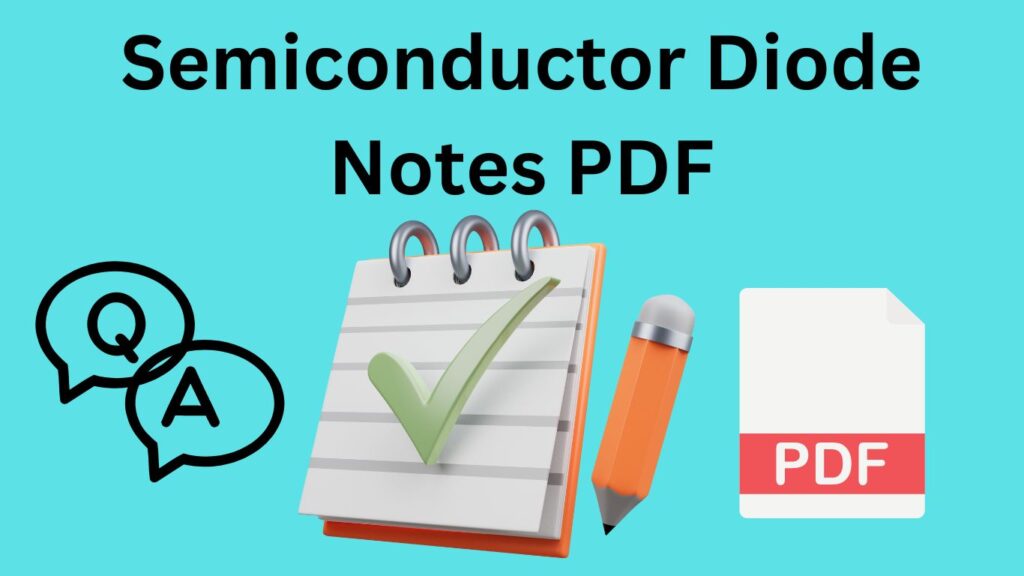Download Semiconductor Diode Handwritten Notes PDF:
Semiconductor diodes play a fundamental role in electronics, serving as essential components in various electronic circuits. Understanding their principles, characteristics, and applications is crucial for students and professionals alike. In this article, we delve into the world of semiconductor diodes, focusing on important topics covered in handwritten notes.
How to get Semiconductor Diode Handwritten Notes for free?
Simply click on the given link to get Semiconductor Diode Handwritten Notes PDF.
Download Now
Download Semiconductor Related Other Notes PDF
Introduction to Semiconductor Diodes
Semiconductor diodes are devices composed of semiconductor materials, typically silicon or germanium, with a P-N junction. They allow current to flow in one direction while blocking it in the opposite direction. Their significance in electronics stems from their ability to regulate voltage, rectify alternating current (AC) into direct current (DC), and serve as key components in electronic circuits.
Basic Structure of Semiconductor Diodes
The basic structure of a semiconductor diode consists of a P-N junction, where P-type semiconductor material (with excess positive charge carriers) is fused with N-type semiconductor material (with excess negative charge carriers). This junction forms the basis of diode operation, enabling the flow of current under certain conditions.
Working Principle of Semiconductor Diodes
Semiconductor diodes operate based on two key principles: forward bias and reverse bias. In forward bias, applying a positive voltage to the P-region and a negative voltage to the N-region allows current to flow across the junction. Conversely, in reverse bias, applying a negative voltage to the P-region and a positive voltage to the N-region blocks current flow.
Types of Semiconductor Diodes
There are several types of semiconductor diodes, each tailored for specific applications. These include the PN junction diode, which is the most common type used for general-purpose rectification and signal demodulation. Zener diodes are employed for voltage regulation purposes, while Schottky diodes offer fast switching speeds and low forward voltage drop.
Applications of Semiconductor Diodes
Semiconductor diodes find extensive use in various electronic applications. They are integral components in rectifier circuits, converting AC voltage to DC voltage. Additionally, Zener diodes are employed for voltage regulation in electronic circuits, ensuring a stable output voltage. Light-emitting diodes (LEDs) utilize semiconductor diodes to emit light efficiently, making them crucial in display and lighting applications.
Semiconductor Diode Characteristics
The characteristics of semiconductor diodes vary depending on factors such as forward and reverse bias voltages, current-voltage relationship, and temperature. Understanding these characteristics is essential for designing and analyzing electronic circuits involving diodes.
Importance of Semiconductor Diode Handwritten Notes
Handwritten notes on semiconductor diodes offer a personalized learning experience for students and professionals. They provide a concise yet comprehensive overview of key concepts, aiding in concept reinforcement and retention of information. Moreover, handwritten notes serve as valuable revision material, enabling learners to review essential topics at their own pace.
Key Topics Covered in Semiconductor Diode Handwritten Notes
Semiconductor diode handwritten notes cover a range of important topics essential for understanding diode operation and applications. These include characteristics of PN junction diodes, Zener diode voltage regulation principles, various rectification techniques, and practical applications of diodes in electronic circuits.
Advantages of Handwritten Notes
The advantages of utilizing handwritten notes for semiconductor diode studies are manifold. Handwritten notes offer a personalized learning experience, allowing students to annotate and highlight key concepts based on their understanding. Furthermore, handwritten notes promote active engagement and deeper comprehension of complex topics, enhancing overall learning outcomes.
Tips for Effective Utilization of Semiconductor Diode Handwritten Notes
To maximize the benefits of semiconductor diode handwritten notes, students are encouraged to adopt effective study strategies. Regular review of notes facilitates information retention, while engaging in problem-solving activities helps reinforce understanding of diode principles. Additionally, employing interactive learning techniques such as group discussions and concept mapping enhances comprehension and knowledge retention.
Conclusion
In conclusion, semiconductor diodes are essential components in electronics, with diverse applications ranging from rectification to voltage regulation and signal demodulation. Handwritten notes provide a valuable resource for students and professionals seeking to grasp the intricacies of semiconductor diodes, offering a personalized and comprehensive learning experience.